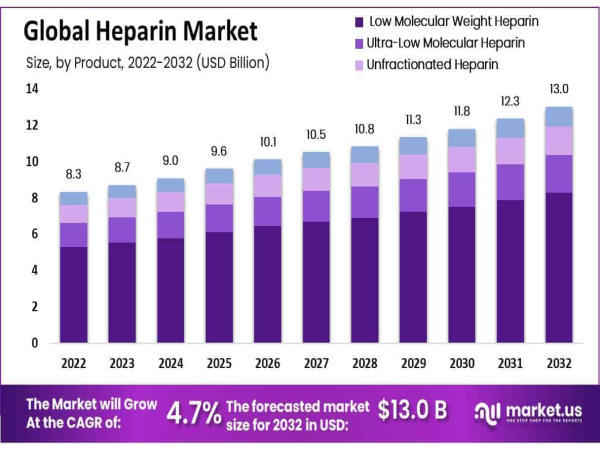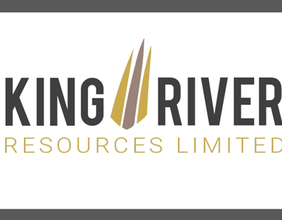The Global Heparin Market size is expected to be worth around USD 13.0 Billion by 2032 from USD 8.7 Billion in 2023, growing at a CAGR of 4.70% during the forecast period from 2023 to 2032.
Heparin, a widely used anticoagulant, plays a crucial role in preventing and treating blood clots. Commonly administered in hospitals, it is essential for surgeries, dialysis, and deep vein thrombosis (DVT) management. Derived from animal tissues, primarily porcine intestines, heparin works by inhibiting clot formation, ensuring smooth blood flow.
The global demand for heparin is rising due to increasing cardiovascular diseases and surgical procedures. The pharmaceutical industry continuously enhances production processes to maintain purity and effectiveness. With growing concerns over contamination and supply chain disruptions, synthetic alternatives are under research.
Regulatory authorities, including the FDA and EMA, enforce strict quality standards to ensure patient safety. Leading pharmaceutical companies continue to invest in innovation to improve heparin formulations. As the healthcare sector advances, the demand for reliable anticoagulants like heparin remains vital, driving market growth and research efforts worldwide.
Unlock Competitive Advantages With Our PDF Sample Report https://market.us/report/heparin-market/request-sample/
Key Takeaways
• Market Size: Global Heparin Market size is expected to be worth around USD 13.0 Billion by 2032 from USD 8.7 Billion in 2023.
• Market Growth: The market growing at a CAGR of 4.70% during the forecast period from 2023 to 2032.
• Surgical and Medical Applications: Heparin is essential for surgical procedures, including heart surgeries, and is widely used to treat deep vein thrombosis (DVT) and pulmonary embolism (PE).
• Biotechnology Advancements: Ongoing research and innovations aim to enhance the safety and efficacy of heparin-based treatments.
• Anticoagulation Reversal: Heparin’s effects can be counteracted with protamine sulfate, ensuring effective management of excessive anticoagulation in medical emergencies.
• Regulatory Oversight: Organizations like the FDA enforce stringent quality and safety standards to protect patients and maintain product integrity.
• Economic Impact: Heparin-based medications significantly influence healthcare budgets, with pricing playing a crucial role in market dynamics and accessibility.
Scope of the Report:
The global Heparinindustry report provides insights into production, consumption, and revenue data across various regions. This research report offers a comprehensive market evaluation, covering future trends, growth drivers, key insights, and verified industry data. It also highlights market share and growth rates across major regions.
Key market players and manufacturers are included in the report, offering a detailed analysis of industry trends and strategic developments. The findings enhance market understanding, enabling informed decisions related to geographical expansion, capacity growth, and new opportunities. The primary market drivers focus on global business expansion. Additionally, the report presents trends, advancements, material insights, technological developments, and the evolving market structure.
Key Highlights of the Heparin Market Study
The insights presented in this report offer critical statistical data and key figures, enabling stakeholders to evaluate market trends, strategize effectively, and enhance their competitive ranking. Researchers have conducted a thorough Strengths, Weaknesses, Opportunities, Threats (SWOT) analysis, along with identifying major challenges to provide a comprehensive market assessment. Additionally, experts have utilized PESTEL analysis and Porter’s Five Forces framework to examine external market influences. By combining quantitative and qualitative research approaches, this study provides a deeper understanding of the Heparin market, helping businesses establish a strong market presence.
Market Segments:
Product
• Weight Heparin
• Unfractionated Heparin
• Ultra-Low Molecular
• Low Molecular Weight Heparin
Application
• Coronary Artery Disease
• Atrial Fibrillation
• Venous Thromboembolism
• Others
Distribution Channel
• Online Pharmacies
• Hospital Pharmacies
• Drug Stores & Retail Pharmacies
Buy This Premium Research Report@ https://market.us/purchase-report/?report_id=15768
Market Dynamics
Driver: Rising Incidence of Cardiovascular Diseases
The increasing prevalence of cardiovascular diseases (CVDs) significantly propels the heparin market. According to the World Health Organization, CVDs are the leading cause of death globally, accounting for approximately 17.9 million deaths annually. Heparin, an anticoagulant, is extensively used in the prevention and treatment of conditions such as deep vein thrombosis and pulmonary embolism, which are common complications associated with CVDs. The growing number of surgical procedures, including coronary artery bypass grafting, further escalates the demand for heparin. As the global population ages and the incidence of lifestyle-related risk factors increases, the reliance on heparin in medical interventions is expected to rise, thereby driving market growth.
Trend: Development of Low Molecular Weight Heparin (LMWH)
A notable trend in the heparin market is the shift towards Low Molecular Weight Heparin (LMWH) formulations. LMWH offers advantages over unfractionated heparin, including more predictable pharmacokinetics, reduced risk of heparin-induced thrombocytopenia, and the convenience of subcutaneous administration without the need for routine monitoring.
These benefits have led to increased adoption of LMWH in clinical practice. Guidelines from health authorities, such as the American College of Chest Physicians, recommend LMWH for various indications, including venous thromboembolism prophylaxis in surgical patients. The ongoing research and development efforts to enhance LMWH formulations and expand their therapeutic applications further contribute to this trend.
Restraint: Supply Chain Disruptions and Quality Concerns
The heparin market faces challenges related to supply chain disruptions and quality control issues. Heparin is primarily derived from porcine intestinal mucosa, making its supply vulnerable to factors affecting pig populations, such as diseases and trade restrictions. For instance, outbreaks of African swine fever have previously led to shortages of raw materials necessary for heparin production.
Additionally, concerns regarding contamination and variability in heparin products have prompted stringent regulatory scrutiny. The U.S. Food and Drug Administration has implemented rigorous quality standards to ensure the safety and efficacy of heparin products. These supply and quality challenges can constrain market growth by affecting product availability and increasing production costs.
Opportunity: Advancements in Synthetic Heparin Production
Advancements in biotechnology present opportunities for the development of synthetic heparin alternatives. Synthetic heparins aim to overcome limitations associated with animal-derived products, such as supply variability and contamination risks. Research efforts are focused on creating fully synthetic heparin molecules that replicate the anticoagulant properties of natural heparin.
These innovations have the potential to provide a more consistent and reliable supply of heparin, enhance patient safety, and reduce dependence on animal sources. As these synthetic alternatives progress through clinical development and regulatory approval, they may significantly impact the heparin market by offering new therapeutic options and addressing existing challenges.
Key Objectives Of The Heparin Global Market:
• To analyze the global Heparin market consumption, industry size estimation, and forecast.
• To understand the general trends of the global Heparin market by understanding its segments and sub-segments.
• Focuses on the leading manufacturers of the Global Heparin market to analyze, describe and develop the company's share, revenue, market value, and competitive landscape of the company over the years.
• To analyze the Heparin market in terms of upcoming prospects, various growth trends, and their contribution to the international market.
• To analyze the production/consumption analysis of the global Heparin market with respect to key regions.
• To get detailed statistics about the key factors governing the growth potential of the global Heparin market.
Key Market Players:
• GlaxoSmithKline plc
• Aspen Pharmacare Holdings Limited
• Braun Medical Inc.
• Baxter International Inc.
• Cipla Ltd.
• Reddy's Laboratories Ltd.
• Hoffmann-La Roche Ltd.
• Fresenius SE & Co. KGaA
• Leo Pharma A/S
• Novartis AG
• Pfizer Inc.
• OPOCRIN SPA.
• Reddy's Laboratories Ltd.
• SARIA International GmbH
• Sanofi
• Teva Pharmaceutical Industries Ltd.
• United Biotech (P) Ltd.
• Viatris Inc.
• Bio-pharma Co., ltd.
• Other Key Players.
Regional Analysis:
• North America (Panama, Mexico, Barbados, United States, Canada, Puerto Rico, Trinidad, and Tobago, etc).
• South and Central America (Brazil, Chile, Argentina, Belize, Costa Rica, Panama, Guatemala, El Salvador).
• Europe (Spain, Belgium, France, Holland, Germany, Sweden, Switzerland, San Marino, Ireland, Norway, Luxembourg, etc).
• Asia-Pacific (Qatar, China, India, Hong Kong, Korea, Israel, Australia, Singapore, Japan, Kuwait, Brunei, etc.).
• The Middle East and Africa (United Arab Emirates, Egypt, Algeria, Nigeria, South Africa, Angola, Saudi Arabia, Bahrain, Oman, Turkey, Lebanon, etc.).
Key questions answered in the report include:
• What are the key factors driving the Heparin market?
• What was the size of the Emerging Heparin Market in Value in 2024?
• What will be the size of the Emerging Heparin Market in 2033?
• Which region is projected to hold the highest market share in the Heparin market?
• What is the market size and forecast of the global Heparin market?
• What products/segments/applications/areas will be invested in the Global Heparins Market during the forecast period?
• What are the technological trends and regulatory framework of the Global Heparin market?
• What is the market share of the key vendors in the global Heparin market?
• What are the right modes and strategic moves to enter the Global Heparin Market?
Reasons to Acquire This Report
- Provides a comprehensive industry outlook, covering global market trends and high-growth segments.
- Includes market share analysis of leading players, company profiles, and critical industry insights.
- Identifies emerging trends, high-growth regions, and market drivers, restraints, and opportunities.
- Examines the latest technological advancements and innovations across various industries.
- Estimates current market size and future growth potential across key applications and industries.
Emerging Trends in Heparin Use
1. Exploration in COVID-19 Treatment: Recent studies suggest that heparin may help treat severe COVID-19 cases by preventing blood clots and reducing inflammation. Its potential to inhibit the virus's entry into cells is also under investigation.
2. Development of Synthetic Alternatives: To address concerns about contamination and supply issues with animal-derived heparin, researchers are creating synthetic versions. These alternatives aim to provide consistent quality and reduce reliance on animal sources.
3. Personalized Dosing Strategies: Advancements in machine learning are being applied to determine personalized heparin dosing. This approach seeks to optimize treatment effectiveness and minimize risks by tailoring doses to individual patient needs.
Use Cases of Heparin
1. Heart Surgery: Heparin is commonly used during heart surgeries to prevent blood clotting. Its anticoagulant properties are essential for patient safety during these procedures.
2. Dialysis: Patients undergoing dialysis often receive heparin to prevent clot formation in the dialysis machine. This ensures the smooth flow of blood during treatment.
3. Deep Vein Thrombosis (DVT) Prevention: Heparin is used to prevent and treat DVT, a condition where blood clots form in deep veins, usually in the legs. This helps reduce the risk of complications like pulmonary embolism.
4. Pulmonary Embolism (PE) Treatment: In cases of PE, where clots travel to the lungs, heparin is administered to prevent further clotting and aid in patient recovery.
5. Atrial Fibrillation Management: For patients with atrial fibrillation, a heart rhythm disorder, heparin is used to prevent stroke by reducing the formation of clots.
6. Use in Interventional Radiology: Heparinized saline is utilized during certain radiological procedures to maintain catheter patency and prevent clot formation.
Check More Healthcare Reports:
Pediatric Medical Devices Market - https://market.us/report/pediatric-medical-devices-market/
Intracranial Pressure Monitoring Devices Market - https://market.us/report/intracranial-pressure-monitoring-devices-market/
Aesthetic Implants Market - https://market.us/report/aesthetic-implants-market/
Medical Transcription Software Market - https://market.us/report/medical-transcription-software-market/
Fibrin Sealants Market - https://market.us/report/fibrin-sealants-market/
Transcatheter Embolization And Occlusion Devices Market - https://market.us/report/transcatheter-embolization-and-occlusion-devices-market/
Lawrence John
Prudour
+91 91308 55334
email us here
Legal Disclaimer:
EIN Presswire provides this news content "as is" without warranty of any kind. We do not accept any responsibility or liability for the accuracy, content, images, videos, licenses, completeness, legality, or reliability of the information contained in this article. If you have any complaints or copyright issues related to this article, kindly contact the author above.
![]()






